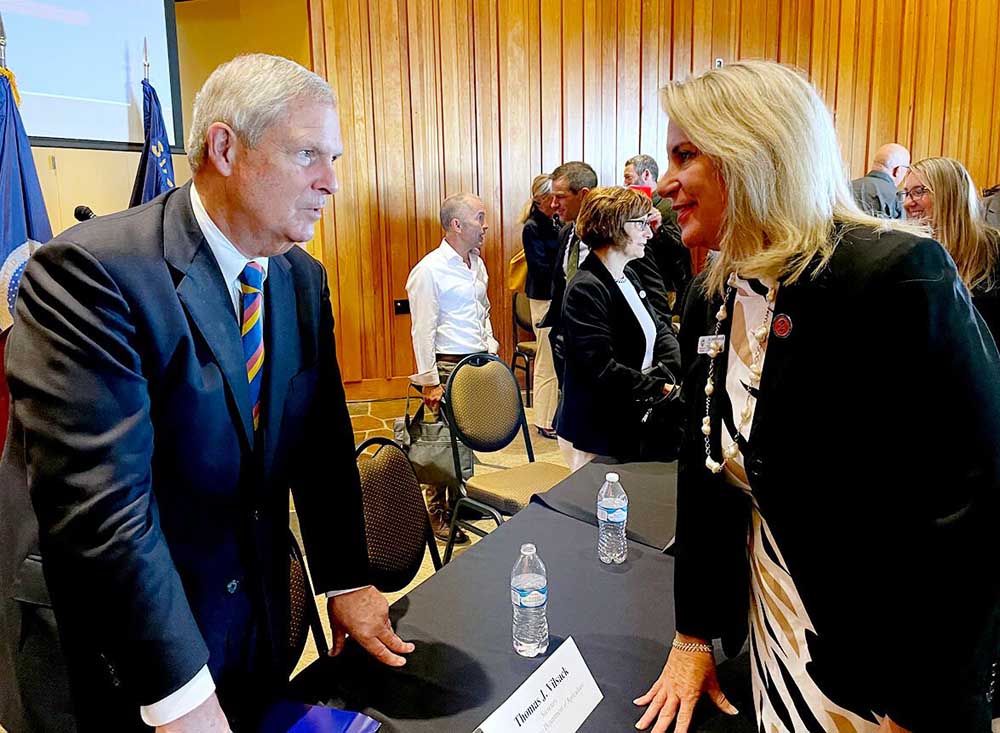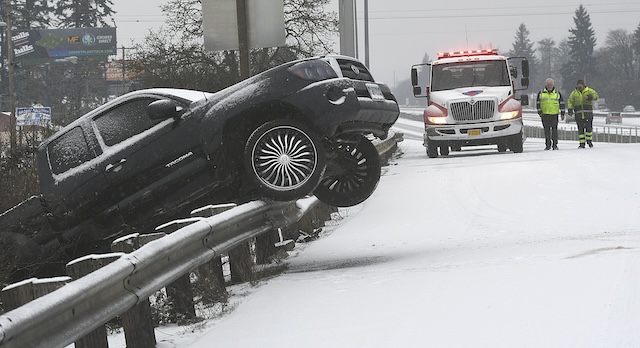New federal grants to help communities bolster fire defenses
Published 8:45 am Tuesday, August 1, 2023

- Agriculture Secretary Tom Vilsack speaks with Staci Simonich, dean of the College of Agricultural Sciences at Oregon State University, following a panel discussion Monday on wildfire resiliency in Portland.
PORTLAND — The Biden administration is investing another $250 million in grants for communities to bolster their defenses against increasingly large and destructive wildfires.
Agriculture Secretary Tom Vilsack announced the funding during a panel discussion Monday at the World Forestry Center in Portland. Gov. Tina Kotek, U.S. Sen. Ron Wyden and Reps. Suzanne Bonamici and Andrea Salinas, both Democrats, also took part.
Congress established the Community Wildfire Defense Grant program in 2021 as part of the Bipartisan Infrastructure Law to help cities, tribes, nonprofits and state forestry agencies maintain wildfire-resilient landscapes.
Earlier this year, the U.S. Forest Service awarded $197 million for 99 projects in 22 states and seven tribes. Ten projects were approved in Oregon to reduce hazardous fuels, create defensible space around homes and update local wildfire response plans.
The agency is now accepting applications for a second round of grants, due Nov. 29.
“This is a part of our effort at USDA to use the resources that Congress has provided to help build up the capacity and resilience of these forested areas,” Vilsack said.
Treating forests
Projects funded by the Community Wildfire Defense Grant program directly support the Forest Service’s 10-year strategy for confronting wildfires.
The plan calls for treating up to 20 million acres of national forests and grasslands. Vilsack said the agency has identified 134 “priority landscapes” for wildfire fuel reduction, including 18 in Oregon. One of the highest priority areas is in Wasco County.
Steve Kramer, chairman of the Wasco County Commission, said the county’s forest collaborative group — formed in 2015 — has already planned seven restoration projects with the Forest Service treating 30,000 acres.
This year marks the first commercial timber sale from that effort, Kramer said. It will benefit schools, county roads and future forest projects.
“This is a huge win for our community, the economy and our wildfire resiliency,” Kramer said. “(But) we need to act with urgency.”
‘We are back’
Memories of the 2020 Labor Day wildfires that burned more than 1 million acres in Western Oregon lingered during the panel’s discussion, underscoring the need to act quickly.
Jim Trett, mayor of Detroit, Oregon, recalled how the Beachie Creek and Lionshead fires destroyed 90% of his community in the densely wooded Santiam Canyon.
For three years, Trett said the community has focused on rebuilding. At the same time, he said, it needs help from the Forest Service to treat hundreds of thousands of acres of dead, fire-scarred trees that not only pose a safety risk, but have deterred public recreation, which is the city’s economic lifeblood.
“We are surrounded by federal land that was devastated,” Trett said. “There is a very real possibility it could burn again.”
The good news, Trett said, is that Detroit is on the road to recovery. He thanked Vilsack for a $1 million U.S. Department of Agriculture grant to install a temporary water system, though it already needs to be expanded as residents get back on their feet.
“Detroit is not dead,” he said. “We are back.”
Creating markets
It’s one thing to thin fuels and manage forests more responsibly, Vilsack said. The question then becomes what to do with all the wood.
Mass timber is one promising solution, Vilsack said. The USDA created a Wood Innovations Grants program in 2015 to spur investment. Since then, he said, there are more than 1,600 building projects either in construction or development using mass timber.
“We need to figure out more creative ways to convert wood waste into more products,” Vilsack said.
Tyler Freres, vice president of Freres Engineered Wood in Lyons, told the story about his company’s development of mass plywood, which is being used in projects such as the new terminal roof at Portland International Airport and a nearly completed 19-story building in Oakland, California.
But the industry continues to face an existential threat due to rapidly shrinking supply of timber harvested from federal lands, Freres said.
The Detroit Ranger Station — part of the Willamette National Forest — once supplied more than 200 million board-feet annually, Freres said. Now, it struggles to supply even one-tenth of that volume. The result is skyrocketing log prices, with imported timber from places like Russia and China filling the gap.
“Instead of responsibly using resources locally in a forest-to-frame manner, we not only encourage but fund the worst environmental actors in the world,” Freres said. “With a warming climate, it is incumbent on us to manage our resources, reduce fuel loading in our forests and allow rural communities to sleep soundly without fear of catastrophic wildfires.”
Firefighter pay
Wyden, Oregon’s senior U.S. senator, said Congress must ensure firefighters are paid fairly to boost retention. Short-term pay increases of $20,000 for about 16,000 federal firefighters are set to expire Sept. 30.
“This is a question about blue-collar people standing up for blue-collar communities so they can be safe,” Wyden said.
Vilsack agreed, adding that firefighters should also have access to housing and mental health counseling while performing their jobs.
“A stressful job, especially one where lives are threatened every single day, can take its toll,” he said.
A bill was introduced July 12 in the Senate by Sen. Kyrstin Sinema, I-Ariz., that would permanently increase firefighter pay, establish a new pay scale for firefighters and direct federal agencies to study how they can lessen burnout.
Michael Bobic, an assistant engine captain for the Mount Hood National Forest, said firefighters are “underpaid, overworked and expected to do more with less.” In a six-month period during fire season, he said Hot Shot crews might only have 15 days off.
Unless Congress passes the Wildland Firefighter Paycheck Protection Act, he said, his pay could be reduced back to $15 per hour.
“I hope you guys can make our jobs fair,” Bobic said.








